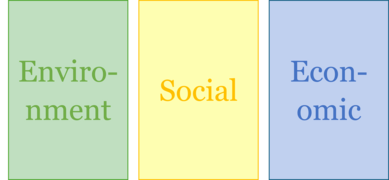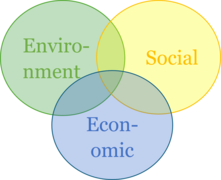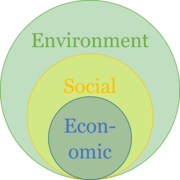Below are common ways of framing sustainability, with varying levels of interactivity and dependencies between different sustainability aspects. They range from considering sustainability topics independently to reflecting on humanity's understanding of its place in the biosphere. This is not an exhaustive list but provides some ways of thinking about sustainability topics. They are intended to provide some examples of how topics within sustainability may relate to one another.
This summary is not intended to adjudicate different models, or provide an academic list of definitions, but rather to give you some ways of thinking about sustainability to reflect upon. This brief descriptions are intended to provide some information about the framework, which you can further research and consider. Ways of thinking about sustainability are constantly expanding and are often contested across and within disciplines. If there are other ways of framing you would recommend we include, or if you have suggested edits, please email us.
3 Pillars
Environmental, social, and economic are the three most commonly referenced pillars of sustainability. Environmental sustainability considers the natural world and preservation of natural resources. Social sustainability considers human needs and supporting people and society. Economical sustainability considers financial

3 Overlapping Circles
Often visualized as a Venn diagram, the 3 Overlapping Circles considers the environmental, social, and economic factors of sustainability and acknowledges the intersection between them (Willard, 2010). This draws on the 3 pillars above, but begins to explore interconnections, trade-offs, and overlap between them.

3 Nested Dependencies
The 3 Nested Dependency model reflects the dependent reality of environmental, social, and economic factors of sustainability. It includes the economy as a subsidiary of society, and society as a subsidiary of the environment (Willard, 2010). Rather than a Venn diagram, these consist of three concentric circles, which begin drawing much more clarity on the relationships between different human and ecological systems.

Deep Sustainability
Deep sustainability refers to the integration of humans into the biosphere in all aspects of life. It considers earth’s systems and the place of humans within them, desiring for them to be reciprocal (Martin, 2022). This can include ecocentric versus anthropocentric worldviews.
Indigenous Peoples and Sustainability Mindsets
Many Indigenous scholars recognize the complex proposition of sustainability as not limited to a technical or rational problem, but also consider our approach as a relational problem. This mindset considers the interconnectedness of humans and the natural world rather than breaking the content of sustainability into compartmentalized or discreet parts for examination and analysis.
Sources
Willard, B. (2010, July 20). 3 sustainability models. Sustainability Advantage. https://sustainabilityadvantage.com/2010/07/20/3-sustainability-models/
Martin, G. T. (2022). Deep Sustainability: The UN Sustainable Development Goals versus the Unworkable UN System. Mind and Society, 11(01), 10–14. https://doi.org/10.56011/mind-mri-111-20221